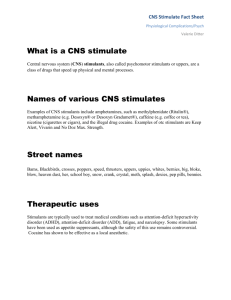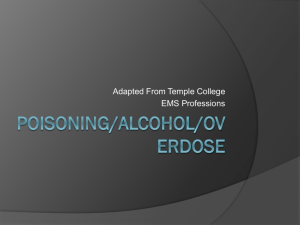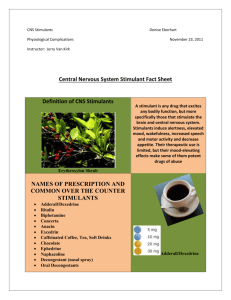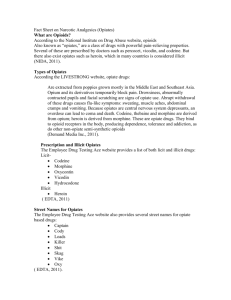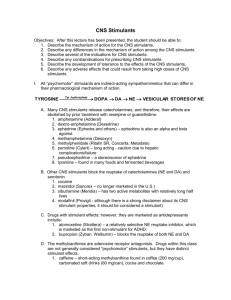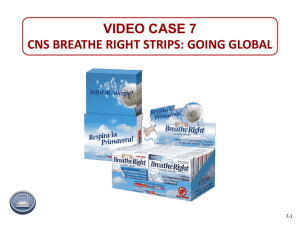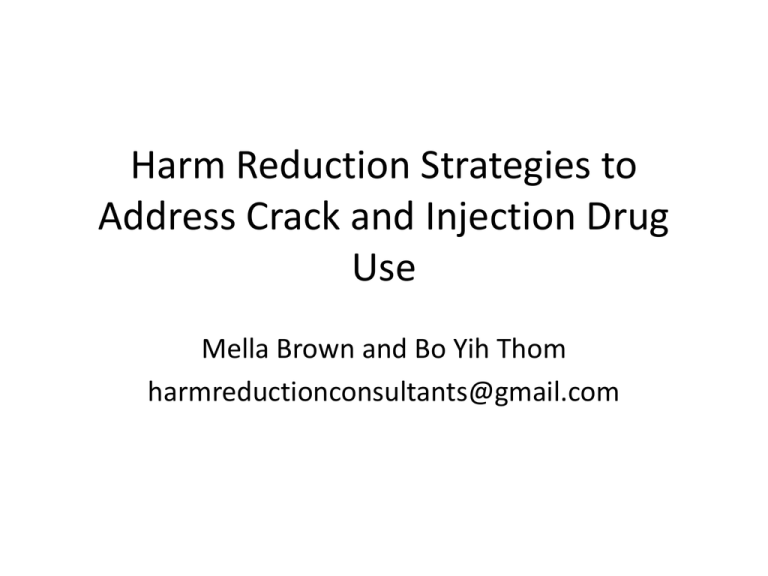
Harm Reduction Strategies to
Address Crack and Injection Drug
Use
Mella Brown and Bo Yih Thom
harmreductionconsultants@gmail.com
Types of Drugs
• Focus on:
– Opiates
– CNS Stimulants
– Alcohol
• Women are often poly drug users
Opiates
• Painkillers
- percocet, oxycodone, fentanyl, heroin,
morphine, demerol, delaudid, etc.
- physical and emotional pain
• Central Nervous System(CNS) Depressant
– brain and spinal cord work together to process
info from senses and respond
How are opiates used?
• Pills
- swallowed, crushed and snorted, or injected
• Heroin
- smoked, snorted, or injected
• Methadone
– By prescription, daily “drink”
Some effects of opiates
• A happy “glow” 4-8 hours
• Comfortable numbness
• Sedation/sleepiness, “on the nod”
• Heart rate decreases
• Brain chemistry changes to accommodate the
presence of opiates = physical withdrawal
Opiate Withdrawal
• Physical
• “junk sick” – up to 4 weeks, up to 3 months for
Methadone
• Flu x 1000
• Aching, sweating, vomiting, muscle pain, diarrhea
• Kick kits (valium, clonidine, and immodium)
• Methadone prescribed for long term users
• Ear acupuncture – NADA protocol
Overdose awareness
• CNS is so suppressed, breathing stops
• Unconscious, blue lips and fingertips
• Mixing uppers and downers is also dangerous –
confuses the body, can’t tell how high you are
• Call 911 – Narcan needs to be administered
– be prepared for paramedics and police
Health Promotion Strategies
Health Promotion Strategies:
• Access to new “works” (injection equipment) and information,
24hrs, anonymous (not having to go through a worker)
• Sharps containers
• Mark own works
• Separate snorting material
• Develop safety strategies based on what she feels is realistic and a
priority
• Discuss vein care, rotating veins, vein cream (vitamin e, preparation
h, polysporin)
• Use ½ the amount if tolerance has lowered
• Resources that are light on toner
Stimulants
• “Uppers”
• CNS Stimulant
• Cocaine, crack
• Speed
• Crystal Meth
How are stimulants used?
• Swallowing
- pills, tablets – speed, “bennys”
• Snorting
- cocaine, speed, crystal meth
• Smoking
- crack and crystal meth
• Injection
- all can be injected
Some effects of stimulants
• Euphoric feelings, 5-15 minutes
• Can be more social, confident, energetic,
talkative, hyper (alert), or anxious
• Shorter half life = more frequent administration
• Cookie feet
• Loss of appetite
• Dehydration
• Increased heart rate
Withdrawal from Stimulants
• Primarily psychological – urges to use can still be very strong
• Happy brain chemicals (seratonin, dopamine) are depleted
• Big emotions, emotional and physical pain
• Hopelessness and self loathing – watch for suicidality
• Extremely tired
• Irritable, sensitive to light, noise
• Lasts about 3 days
Overdose awareness
• Severe dehydration, overheating, lack of sleep,
water and nutrients
• Seizures, “doing the chicken”
– Often in sets of 3
– Protect head, never put anything in mouth
– Cool down with wet towels in armpits, backs of knees,
luke warm shower with a friend, let her make the
water cooler by herself
• Stop using for now
Harm Reduction Strategies
• Strategies re: hydration, food, and sleep
• Support to understand withdrawal symptoms as a
part of using (hangover)
• Collect resin with a plastic straw instead of a
metal blade
• Access to safer crack use kits which address
dangers associated with homemade pipes
– HIV and HCV, damage to lungs from metal fatigue,
health problems associated with aluminum foil,
aluminum cans, and chemicals from heated plastic
Hepatitis C
•
•
•
•
•
In blood
Destroys liver
Very hardy virus
Transmitted through white blood cells
Many strands
• Interferon (will need support), milk thistle
Toxic pipes – Tin Can
•
•
•
•
•
aluminum
Plastic coating
Ashes
Debris
Sharp edges
• Worst health choice
• Most popular where barriers exist because it’s
quick and disposible
Toxic Pipes – Copper Elbow
•
•
•
•
Aluminum
Ask
Copper in lungs from collecting resin
Hot – can cause burns
• “An old friend”
Toxic pipes – Asthma inhaler
•
•
•
•
Aluminum
Plastic
Ashes
Ingestion of plastic from scraping
Toxic Pipes – Water Bottle
• Plastic
• Ashes
• Aluminum
Toxic Pipes – Ginseng Bottles
• Metal fatigue
• Sharp edges, cuts and burns
Safer Crack Use Kits
•
•
•
•
Sturdy Pyrex
Screens reduce damage to lungs
Health promotion messages
Supplies for 1+
A note on cigarrettes
• Knock out the ash
• Cover the filter
Alcohol
• CNS depressant
• Ingested by drinking
• Wine, beer, liquor, cooking wine, hand
sanitizer, mouthwash
Some effects of alcohol
• Happy at first, but can bring on difficult
emotions and depression
• Impaired thinking and memory
• Decreased fine motor skills
• Decreased perception (pain, time)
Withdrawal
• Insomnia, sweats and shakes
• Can lead to seizures
- non-medical withdrawal management
services (detox) may require initial
supervision in hospital
Harm Reduction Strategies
• Mixing alcohol with other CNS depressants
(heroin, methadone, percocet) is extremely
dangerous. It is also dangerous to mix with
benzodiazepines (valium)
• Alcohol is really bad on the liver, a concern for
those living with Hepatitis C (HCV)
• Pace drinking, alternate with water, teas, etc.
• Safety planning – a place to pass out
• Taper instead of “cold turkey” if drinking heavily
Resources
• Harmreductionconsultants@gmail.com
• CATIE – free, excellent harm reduction
information in easy to read formats
• Toronto Public Health – Narcan training
416-392-0520
• National Acupuncture Detoxification Association
(NADA)

